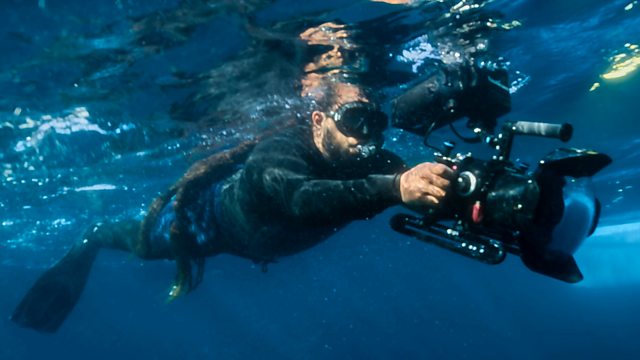Summer
Wildlife cameraman Hamza Yassin spends the summer months revealing hidden natural spectacles throughout the British Isles.
Wildlife cameraman Hamza Yassin spends the summer travelling the UK to track down and reveal some of the most hidden wildlife spectacles in our warmest months.
His journey takes him from the vast open ocean of the Irish Sea to the heart of Leeds and up to his remote home on the west coast of Scotland, with many other places between. Along the way, he meets old friends and passionate conservationists, who help to reveal the hidden beauty of the British summer. Hamza begins his journey out at sea, 40 miles off the coast of south west Wales. With the summer sun beating down on him, he gets his first ever glimpse of an incredible ocean nomad: a two-metre long blue shark that, for a few short weeks each summer, calls our coasts its home. From here, Hamza heads north to his home in Kilchoan on the Ardnamurchan Peninsula. He moved there 16 years ago and has made lasting and deep friendships with residents of his small village. His first few years were supported by his neighbour Amanda, who Hamza often refers to as his Scottish mother. For a special treat, Hamza takes Amanda on a walk along their familiar coastal paths to try to catch a glimpse of one of our most elusive and hard-to-spot mammals: the otter. Even though the west coast of Scotland is possibly the best place to spot otters in the whole of the UK, Amanda still rarely sees them. And so, with Hamza’s expertise, they head out onto the rocks and into the seaweed to spend the day together in search of this shy aquatic creature. Unfortunately, the weather has other plans. The long-awaited summer has yet to arrive in Scotland.
Hamza’s next hidden creature is back down south – all the way to the RSPB’s Arne Reserve on the Isle of Purbeck in Dorset. This is one of the most biodiverse places in the British Isles, with hundreds of rare, special animals and plants adding to the rich tapestry of life. One species in particular heads here for the summer months, and for centuries it has been shrouded in folklore, capturing imaginations due to its bizarre appearance, unearthly call and nocturnal activities. A strange, pigeon-sized brown bird called a nightjar has made its home on the heath, and to reveal its night-time behaviour, Hamza is going to need more than just his regular camera to peer into the night. He is joined by fellow wildlife cameraman Mark Yates, who has brought along one of the most advanced thermal-imaging cameras in the world to help them peel back the cover of darkness and film these alien-like birds in their natural environment.
Arne is also home to millions of tiny creatures that shape and mould the landscape in dramatic fashion. There are hundreds of wood ant colonies here, and with the help of some specialist kit for filming tiny worlds as well as ant expert and insect lover Lucy Hodson, Hamza reveals a hidden empire thriving underground.
Back up in Scotland, an animal emerges that has been missing from our lands for the past 400 years. Signs of its return cover the forest floor: felled trees, stripped bark and huge dams crossing streams and rivers. After exploring the newly developed landscape, Hamza settles into his filming position for the evening alongside a beautiful, calm pond, hoping that wild beavers will emerge and give him an experience that has been centuries in the making.
Heading back down to south Wales, Hamza stops off at a historic stable on the Stackpole Estate in Pembrokeshire. Up in the attic of this ancient building, a very large and special gathering is waking up as the sun sets. Pregnant female greater horseshoe bats have used this building as a maternity roost for longer than living memory, and over a thousand of them are waiting for darkness to emerge and find food. To reveal these hidden creatures of the night, Hamza is going to need some special gadgets. Infrared lights and special cameras give him unparalleled access to the night-time proclivities of these amazing and secretive bats.
On a normally quiet street just outside Leeds, the sound of high-pitched screaming wheels overhead. More than forty pairs of swifts, one of our most threatened bird species, have journeyed back from Africa to nest on this seemingly ordinary suburban road. But Swift Park Avenue is far from ordinary – residents here have spent the last decade creating a hidden sanctuary for the swifts, and Hamza can’t wait to meet them and discover the secrets to their incredible success.
To end his summer of hidden wildlife, Hamza heads back out to sea to search for a much-loved ocean dweller. A pod of common dolphins has been reported patrolling the vast Celtic Sea between Pembrokeshire and Ireland, but they could be anywhere. Armed with a crew of specialist film-makers, Hamza and the team head out into the open ocean to throw every trick they have at finding these ephemeral and intelligent marine mammals.
On TV
More episodes
Previous
Next
Clip
-
![]()
Capturing the Eurasian beaver
Duration: 01:23
Credits
| Role | Contributor |
|---|---|
| Presenter | Hamza Yassin |
| Executive Producer | Alastair Fothergill |
| Series Producer | Laura Howard |
| Director of photography | Jacob Parish |
| Line Producer | Siobhan Brook |
| Producer | Laurence Whitaker |
| Production Company | Silverback Films Ltd |
Broadcasts
- Sunday 18:15
- Sun 26 Oct 2025 14:15ÃÛÑ¿´«Ã½ One London & London HD only
Order your free booklet and postcards from The Open University
Visit The Open University website.
Open your mind to discover nature's hidden wonders on your doorstep
Get to know the UK's natural environment with The National Trust.


